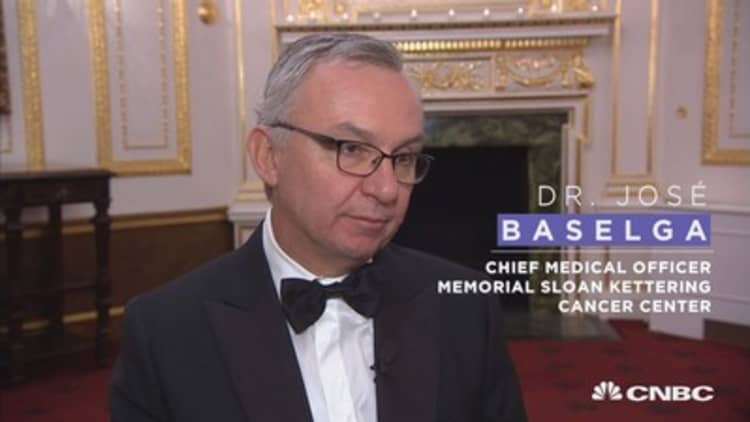The death of a child is an event no parent can ever truly move beyond. Though grief is a lifelong process, for some a personal tragedy such as this can be a springboard to launch an organization focused on bringing attention to an important cause.
That was the case for Jill and Mazen Kamen, who officially launched the Kamen Brain Tumor Foundation last month after losing their 19-year-old son in April to brain cancer. In 2009 he had been diagnosed with a type of rapidly growing brain tumor called a high-grade astrocytoma that, despite aggressive treatment, eventually evolved into a glioblastoma — the highly malignant brain tumor that also took the lives of Vice President Joe Biden's son, Beau, in 2015 and former Sen. Ted Kennedy in 2009.
"The first phase is shock when your child is diagnosed," said Mazen. "You can't believe it. You start questioning the why, the where. It's like someone has hit you with a Mack truck. You have to go through that. But you also have to regroup yourself very quickly, because now you have a long, tedious road ahead. And you really have to do your homework very quickly and efficiently, if you can, to face this."
Glioblastoma multiforme is the most common and deadliest of the glial tumors because the cells reproduce so rapidly. The tumor grows by turning normal brain cells into stem cells, which continuously replicate and regrow. So even if a tumor is surgically removed, it is difficult to extract every cancerous cell; any left behind will result in the growth of a new tumor. The five-year survival rate for children with glioblastoma is 25 percent.

While there are more new cases of leukemia each year than new cases of brain cancer, in 2014 brain cancer surpassed leukemia to become the leading cause of death for those under the age of 19, a result of the great progress that has been made in leukemia treatment over the past five years. In September the Centers for Disease Control and Prevention issued a report highlighting the need for greater investment as well as new approaches for funding and conducting pediatric brain tumor research.
Dr. José Baselga, chief medical officer and physician-in-chief at Memorial Sloan Kettering Cancer Center in New York, says it's organizations such as the Kamen Brain Tumor Foundation that will be instrumental in driving the cure.
"The science is here, so we are pushing hard," he said. "We have a very clear image of how to attack this disease. But, he says, the funding is minimal. "Only 4 percent of the NIH budget is devoted to childhood cancers. To have a foundation that is committed … They'll find sources; they'll create a community of people that will support this research."
Deadly statistics
Currently, there are 28,000 children in the United States living with a malignant brain tumor, and another 4,600 are projected to be diagnosed each year. Yet since 1985, there have been only four FDA-approved drugs to treat the more than 120 different types of brain tumors, according to the National Brain Tumor Society. And none of these are specifically aimed at treating pediatric brain tumors. Between 1998 and 2014, claims the NBTS, 78 investigational brain tumor drugs were entered into the clinical trial evaluation process, and 75 of them failed.
Fortunate to have contacts in the medical field — Mazen is a cardiologist at New York-Presbyterian Hospital and Jill a critical-care nurse by training — the Kamens immediately began investigating treatment protocols. "You need to have at least three or four opinions from major centers, and sometimes you get conflicting opinions," said Mazen. "Not only about the pathology of the tumor but also the treatment. You say, "What do I do? Who should I go with?' Ultimately, it's your gut feeling."
Over the seven years, the Kamens traveled the map, beginning with treatment at Massachusetts General Hospital in Boston, then on to Duke University Medical Center to consult with neuro-oncologist Dr. Henry Friedman, the same doctor who treated former Sen. Ted Kennedy. The Duke team collaborated with Memorial Sloan Kettering in New York to devise a chemotherapy and radiation protocol that could be administered at MSK so their son could be close to home.
"Our son had a mutation," said Mazen. "The question is, what made it mutate? … What we found is that even though you've found the mutation in the tumor, there's no drug to treat it."
Frustrated with the lack of investment in research and drug development devoted to pediatric brain tumor gliomas, the Kamens decided to take action and launch their foundation. Its mission: to fund cutting-edge research to find better and safer treatment options and to provide guidance and support for families who have a loved one dealing with this devastating illness.
"We want to get the word out there that we have been through this experience firsthand. And because we have inside knowledge of the medical community, we feel that we can lend that part of our experience to help others," said Jill.
Their scientific advisory council consists of a number of experts from leading medical institutions, including Memorial Sloan Kettering Cancer Center, New York Presbyterian Hospital's Weill-Cornell Medical Center and Duke University Medical Center.
The science is here, so we are pushing hard. We have a very clear image of how to attack this disease.Dr. José Baselgachief medical officer and physician-in-chief at Memorial Sloan Kettering Cancer Center
The Kamens claim the main thing that distinguishes their foundation from other brain tumor foundations is their focus on pediatric brain cancer specifically, as well as their close ties with pharmaceutical and biotech companies working in the fields of immunotherapy and target gene therapy.
Moving closer toward a cure
Traditional therapies for brain cancer — surgery, chemotherapy and radiation — haven't been very successful, says Memorial Sloan Kettering's Dr. Baselga, adding, "We have a tremendous need to develop new therapies, especially with children." Surgery is difficult, he says, because tumors infiltrate, so it's very difficult to obtain clear margins, and radiation can be risky.
"We have to be very careful, because these children are developing their brains and the consequences of giving full-dose radiation could be lifelong lasting, so we cannot sometimes give full therapy," he said. "And then chemotherapy — you know, the brain is protected. The brain is designed so that toxins would not get there. So it is very challenging to have chemotherapy get to the brain with a good dose."
More from Change the World:
5 ways to teach your kids the art of giving
America's dirty little secret: 42 million people are suffering from hunger
Answering this one question could save the lives of 1 million babies
Instead, Dr. Baselga said researchers and scientists are making strides in what he calls precision medicine, an emerging approach for disease treatment and prevention that takes into account individual variability in environment, lifestyle and genes for each person. Rather than a one-size-fits-all approach, doctors and researchers will be able to predict more accurately which treatment will work for a particular person.
"Today we can sequence," he said. "We can look at the genes that are abnormal in brain tumors [and] develop therapies to attack those genes." The therapies he is referring to are genomic, epigenetic and immune therapies. "This in childhood brain cancers is going to be very promising. We are teaching the immune system how to recognize the tumor cells as something we don't want. We are teaching the T cells, the lymphocytes, multiple cells to be more proactive in cleaning up the cancer cells in the brain. Epigenetic therapy attacks the way genes are being expressed."
A family of visionaries
Launching a foundation would be a daunting task for most, yet for the Kamens it's a natural calling. Mazen is the nephew of Elmer and Mamdouha Bobst — philanthropists who in 1968 established the Elmer and Mamdouha Bobst Foundation in New York. Throughout the years, the Bobsts donated millions to cancer research, education and other causes, including New York University, NYU Langone Medical Center, Princeton University, the Animal Medical Center, Memorial Sloan Kettering Cancer Center and the American Cancer Society. In addition, the Bobsts donated $11 million in 1973 to complete New York University's library on Washington Square, which bears Elmer Bobst's name, along with $10 million to create the Mamdouha S. Bobst Center for Peace and Justice.
"I was blessed and fortunate to have grown in such a family of visionaries. They have given me a lot of advice throughout my life. The most important thing is to help each other. My uncle Elmer always used to remind me of a saying: 'Service is the rent we pay for the space we occupy on Earth,'" said Mazen. "So I think if we are fortunate enough to be in a position to give, then we ought to do that."
With regard to finding better and safer treatment options for children with brain tumor gliomas and providing support for their families, he added: "This is a cause we will be pursuing for the rest of our lives."
This story is part of NBCU's Share Kindness. Follow the series on Facebook, Twitter and Instagram. #ShareKindness





